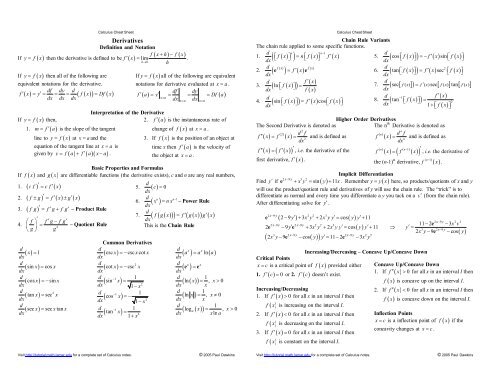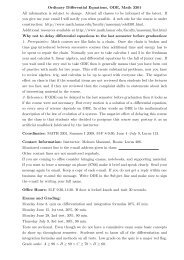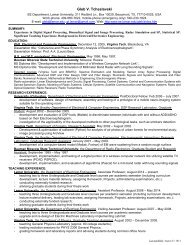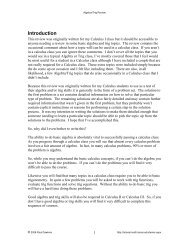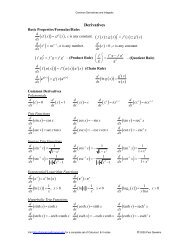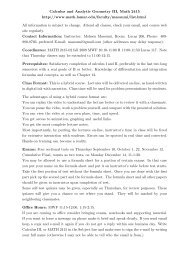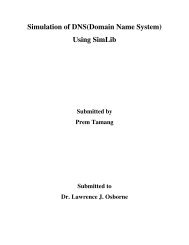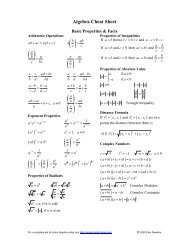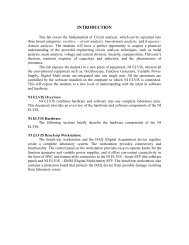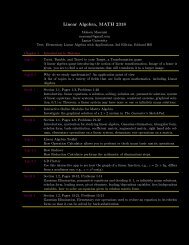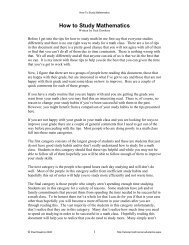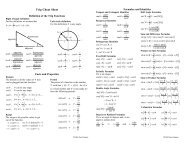Derivatives - Pauls Online Math Notes
Derivatives - Pauls Online Math Notes
Derivatives - Pauls Online Math Notes
- No tags were found...
Create successful ePaper yourself
Turn your PDF publications into a flip-book with our unique Google optimized e-Paper software.
Calculus Cheat Sheet<br />
<strong>Derivatives</strong><br />
Definition and Notation<br />
If y = f ( x)<br />
then the derivative is defined to be f ( x)<br />
If y = f ( x)<br />
then all of the following are<br />
equivalent notations for the derivative.<br />
df dy d<br />
f¢ ( x) = y¢<br />
= = = f ( x)<br />
= Df x<br />
dx dx dx<br />
If y = f ( x)<br />
then,<br />
1. m f¢<br />
( a)<br />
( ) ( )<br />
= is the slope of the tangent<br />
line to y = f ( x)<br />
at x = aand the<br />
equation of the tangent line at x = a is<br />
y = f a + f¢<br />
a x- a .<br />
given by ( ) ( )( )<br />
If f ( x ) and ( )<br />
¢ ¢<br />
1. ( cf ) = cf ( x)<br />
( + ) - ( )<br />
¢ = .<br />
h<br />
h ® 0<br />
f<br />
lim<br />
x h f x<br />
If y = f ( x)<br />
all of the following are equivalent<br />
notations for derivative evaluated at x = a.<br />
df dy<br />
f¢ ( a) = y¢<br />
= = = Df ( a)<br />
x=<br />
a<br />
dx dx<br />
x= a x=<br />
a<br />
Interpretation of the Derivative<br />
f¢ a is the instantaneous rate of<br />
2. ( )<br />
change of f ( x ) at x = a.<br />
3. If f ( x ) is the position of an object at<br />
time x then f¢ ( a)<br />
is the velocity of<br />
the object at x = a.<br />
Basic Properties and Formulas<br />
g x are differentiable functions (the derivative exists), c and n are any real numbers,<br />
¢ ¢ ¢<br />
2. ( f ± g) = f ( x) ± g ( x)<br />
3. ( )<br />
fg ¢ = f¢ g+ fg¢<br />
– Product Rule<br />
æ f ö<br />
¢<br />
f¢ g-<br />
fg¢<br />
4. ç =<br />
2<br />
g<br />
÷<br />
– Quotient Rule<br />
è ø g<br />
d<br />
( x ) = 1<br />
dx<br />
d<br />
( sinx)<br />
= cos x<br />
dx<br />
d<br />
( cosx)<br />
=- sin x<br />
dx<br />
d<br />
2<br />
( tanx)<br />
= sec x<br />
dx<br />
d<br />
( secx)<br />
= secxtan<br />
x<br />
dx<br />
d<br />
dx<br />
d x<br />
n nx<br />
n-<br />
= – Power Rule<br />
dx<br />
d<br />
( f ( g x )) = f¢ g( x)<br />
g¢<br />
x<br />
dx<br />
This is the Chain Rule<br />
5. ( c ) = 0<br />
Common <strong>Derivatives</strong><br />
d<br />
( cscx)<br />
=- cscxcot<br />
x<br />
dx<br />
d<br />
2<br />
( cotx)<br />
=- csc x<br />
dx<br />
d -1<br />
1<br />
( sin x)<br />
=<br />
dx<br />
2<br />
1-<br />
x<br />
d -1<br />
1<br />
( cos x)<br />
=-<br />
dx<br />
2<br />
1-x<br />
d -1<br />
1<br />
( tan x)<br />
2<br />
dx 1 x<br />
6. ( )<br />
1<br />
7. ( )<br />
( ) ( )<br />
d a a a<br />
x x<br />
( ) = ln( )<br />
dx<br />
d x x<br />
( e ) = e<br />
dx<br />
d 1<br />
( ( x)<br />
) x<br />
dx x<br />
d 1<br />
( x ) = x¹<br />
dx x<br />
d<br />
1<br />
= ( a ( x)<br />
)<br />
+<br />
ln = , > 0<br />
ln , 0<br />
log = , x > 0<br />
dx xlna<br />
Calculus Cheat Sheet<br />
Chain Rule Variants<br />
The chain rule applied to some specific functions.<br />
d<br />
n<br />
n-1<br />
d<br />
1. ( éf ( x)<br />
ù ) = né f ( x) ù f¢<br />
( x)<br />
dx<br />
ë û ë û<br />
5. ( coséf ( x)<br />
) f ( x) sin f ( x)<br />
dx<br />
ë ùû =- ¢ éë ùû<br />
d f ( x)<br />
f ( x)<br />
d<br />
2<br />
2. ( e ) = f¢<br />
( x)<br />
e<br />
6. ( tanéf ( x)<br />
) f ( x) sec f ( x)<br />
dx<br />
dx<br />
ë ùû = ¢ éë ùû<br />
d<br />
f¢<br />
( x)<br />
d<br />
3. ( ln éf<br />
( x)<br />
ù)<br />
=<br />
dx<br />
ë û<br />
7. sec[ f ( x) ] = f ¢ ( x) sec f ( x) tan f ( x)<br />
f ( x)<br />
dx<br />
d<br />
d 1<br />
f ( x)<br />
4. ( sinéf ( x)<br />
ù) = f¢<br />
( x) cos éf ( x)<br />
ù<br />
8. ( tan<br />
- éf<br />
( x)<br />
)<br />
¢<br />
2<br />
dx<br />
ë û ë û dx<br />
ë ùû<br />
=<br />
1+éëf ( x)<br />
ùû<br />
( ) [ ] [ ]<br />
Higher Order <strong>Derivatives</strong><br />
The Second Derivative is denoted as<br />
The n th Derivative is denoted as<br />
2<br />
n<br />
( 2<br />
( ) ) d f<br />
( n<br />
f¢¢ x = f ( x)<br />
= and is defined as<br />
) d f<br />
f<br />
2<br />
( x)<br />
= and is defined as<br />
n<br />
dx<br />
dx<br />
f¢¢ ( x) = ( f¢<br />
( x ))<br />
¢ , i.e. the derivative of the<br />
( n ) ( n- 1<br />
( )<br />
) ¢<br />
f x = ( f ( x)<br />
), i.e. the derivative of<br />
first derivative, f¢ ( x)<br />
.<br />
the (n-1) st n-1<br />
derivative, f x .<br />
( )<br />
( )<br />
Implicit Differentiation<br />
+ xy = sin y + 11x<br />
y = y x here, so products/quotients of x and y<br />
2x-9y<br />
3 2<br />
Find y¢ if e ( ) . Remember ( )<br />
will use the product/quotient rule and derivatives of y will use the chain rule. The “trick” is to<br />
differentiate as normal and every time you differentiate a y you tack on a y¢ (from the chain rule).<br />
After differentiating solve for y¢ .<br />
e<br />
( - y¢ ) +<br />
e<br />
x y + xyy¢ = ( y)<br />
y¢<br />
+<br />
( )<br />
-<br />
x- y<br />
e - ( ) ¢ = -<br />
x-<br />
y<br />
e -<br />
2x-9y<br />
2 2 3<br />
2 9 3 2 cos 11<br />
- y¢ + xy + xyy¢ = y y¢ + Þ y¢<br />
=<br />
2x-9y 2x-9y<br />
2 2 3<br />
2e<br />
9 3 2 cos 11<br />
( )<br />
2xy 9 cos y y 11 2 3xy<br />
3 2 9 2 9 2 2<br />
Critical Points<br />
x c<br />
= is a critical point of f ( )<br />
1. f¢ ( c) = 0 or 2. f ( c)<br />
Increasing/Decreasing – Concave Up/Concave Down<br />
¢ doesn’t exist.<br />
x provided either<br />
Increasing/Decreasing<br />
1. If f¢ ( x) > 0 for all x in an interval I then<br />
f ( x ) is increasing on the interval I.<br />
¢ < for all x in an interval I then<br />
2. If f ( x) 0<br />
f ( x ) is decreasing on the interval I.<br />
¢ = for all x in an interval I then<br />
3. If f ( x) 0<br />
f ( x ) is constant on the interval I.<br />
2x-9y<br />
2 2<br />
11-2e<br />
-3x y<br />
3 2x-9y<br />
2xy-9e<br />
-cos<br />
( y)<br />
Concave Up/Concave Down<br />
f¢¢ x > for all x in an interval I then<br />
1. If ( ) 0<br />
f ( x ) is concave up on the interval I.<br />
¢¢ < for all x in an interval I then<br />
2. If f ( x) 0<br />
f ( x ) is concave down on the interval I.<br />
Inflection Points<br />
x c<br />
= is a inflection point of f ( )<br />
concavity changes at x = c.<br />
x if the<br />
Visit http://tutorial.math.lamar.edu for a complete set of Calculus notes.<br />
© 2005 Paul Dawkins<br />
Visit http://tutorial.math.lamar.edu for a complete set of Calculus notes.<br />
© 2005 Paul Dawkins
Absolute Extrema<br />
1. x c<br />
= is an absolute maximum of f ( x )<br />
if f ( c) ³ f ( x)<br />
for all x in the domain.<br />
= is an absolute minimum of f ( x )<br />
2. x c<br />
if f ( c) £ f ( x)<br />
for all x in the domain.<br />
Fermat’s Theorem<br />
f x has a relative (or local) extrema at<br />
If ( )<br />
x = c, then x c<br />
= is a critical point of ( )<br />
Calculus Cheat Sheet<br />
f x .<br />
Extreme Value Theorem<br />
f x is continuous on the closed interval<br />
If ( )<br />
[ ab , ] then there exist numbers c and d so that,<br />
£ £ , 2. f ( c ) is the abs. max. in<br />
1. a cd , b<br />
[ ab , ] , 3. ( )<br />
f d is the abs. min. in [ , ]<br />
ab .<br />
Finding Absolute Extrema<br />
To find the absolute extrema of the continuous<br />
ab , use the<br />
function f ( x ) on the interval [ ]<br />
following process.<br />
1. Find all critical points of f ( x ) in [ ab , ] .<br />
2. Evaluate f ( x ) at all points found in Step 1.<br />
3. Evaluate f ( a ) and f ( b ) .<br />
4. Identify the abs. max. (largest function<br />
value) and the abs. min.(smallest function<br />
value) from the evaluations in Steps 2 & 3.<br />
Extrema<br />
Relative (local) Extrema<br />
1. x = c is a relative (or local) maximum of<br />
f c ³ f x for all x near c.<br />
f ( x ) if ( ) ( )<br />
2. x = c is a relative (or local) minimum of<br />
f c £ f x for all x near c.<br />
f ( x ) if ( ) ( )<br />
1 st Derivative Test<br />
If x c<br />
= is a critical point of ( )<br />
1. a rel. max. of f ( x ) if f ( x) 0<br />
f x then x = c is<br />
¢ > to the left<br />
of x = c and f¢ ( x) < 0 to the right of x = c.<br />
2. a rel. min. of f ( x ) if f ( x) 0<br />
¢ < to the left<br />
of x = cand f¢ ( x) > 0to the right of x = c.<br />
¢ is<br />
3. not a relative extrema of f ( x ) if f ( x)<br />
the same sign on both sides of x = c.<br />
2 nd Derivative Test<br />
If x c<br />
Mean Value Theorem<br />
,<br />
= is a critical point of f ( x ) such that<br />
f¢ ( c) = 0 then x = c<br />
1. is a relative maximum of f ( x ) if f¢¢ ( c) < 0 .<br />
2. is a relative minimum of f ( x ) if f¢¢ ( c) > 0 .<br />
3. may be a relative maximum, relative<br />
minimum, or neither if f¢¢ ( c) = 0 .<br />
Finding Relative Extrema and/or<br />
Classify Critical Points<br />
1. Find all critical points of f ( x ) .<br />
2. Use the 1 st derivative test or the 2 nd<br />
derivative test on each critical point.<br />
If f ( x ) is continuous on the closed interval [ ab ] and differentiable on the open interval ( ab , )<br />
f ( b) - f ( a)<br />
then there is a number a< c < b such that f¢ ( c)<br />
=<br />
.<br />
b-<br />
a<br />
Newton’s Method<br />
If x<br />
n<br />
is the n th guess for the root/solution of f ( x ) = 0 then (n+1) st guess is<br />
provided f¢ ( x n ) exists.<br />
x<br />
x<br />
f<br />
= - n+ 1 n<br />
¢<br />
f<br />
( xn<br />
)<br />
( x )<br />
n<br />
Calculus Cheat Sheet<br />
Related Rates<br />
Sketch picture and identify known/unknown quantities. Write down equation relating quantities<br />
and differentiate with respect to t using implicit differentiation (i.e. add on a derivative every time<br />
you differentiate a function of t). Plug in known quantities and solve for the unknown quantity.<br />
Ex. A 15 foot ladder is resting against a wall.<br />
The bottom is initially 10 ft away and is being<br />
pushed towards the wall at 1 ft/sec. How fast<br />
4<br />
is the top moving after 12 sec<br />
x¢ is negative because x is decreasing. Using<br />
Pythagorean Theorem and differentiating,<br />
2 2 2<br />
x + y = 15 Þ 2xx¢ + 2yy¢<br />
= 0<br />
1<br />
After 12 sec we have ( )<br />
x = 10- 12 = 7and<br />
so y =<br />
2 2<br />
15 - 7 = 176 . Plug in and solve<br />
for y¢ .<br />
1<br />
7<br />
7( -<br />
4 ) + 176 y¢ = 0 Þ y¢<br />
= ft/sec<br />
4 176<br />
4<br />
Ex. Two people are 50 ft apart when one<br />
starts walking north. The angleθ changes at<br />
0.01 rad/min. At what rate is the distance<br />
between them changing when θ = 0.5 rad<br />
We have θ¢ = 0.01 rad/min. and want to find<br />
x¢ . We can use various trig fcns but easiest is,<br />
x<br />
x¢<br />
secθ = Þ secθ tanθθ¢<br />
=<br />
50 50<br />
We knowθ = 0.05 so plug in θ¢ and solve.<br />
x¢<br />
sec( 0.5) tan( 0.5)( 0.01)<br />
=<br />
50<br />
x¢ = 0.3112 ft/sec<br />
Remember to have calculator in radians!<br />
Optimization<br />
Sketch picture if needed, write down equation to be optimized and constraint. Solve constraint for<br />
one of the two variables and plug into first equation. Find critical points of equation in range of<br />
variables and verify that they are min/max as needed.<br />
Ex. We’re enclosing a rectangular field with<br />
2<br />
Ex. Determine point(s) on y = x + 1 that are<br />
500 ft of fence material and one side of the closest to (0,2).<br />
field is a building. Determine dimensions that<br />
will maximize the enclosed area.<br />
Maximize A= xy subject to constraint of<br />
x+ 2y<br />
= 500 . Solve constraint for x and plug<br />
into area.<br />
A= y( 500-2y)<br />
x = 500-2y<br />
Þ<br />
=<br />
2<br />
500y<br />
- 2y<br />
Differentiate and find critical point(s).<br />
A¢ = 500-4y Þ y = 125<br />
By 2 nd deriv. test this is a rel. max. and so is<br />
the answer we’re after. Finally, find x.<br />
x = 500- 2125 = 250<br />
( )<br />
The dimensions are then 250 x 125.<br />
2 2<br />
2<br />
Minimize f d ( x 0) ( y 2)<br />
= = - + - and the<br />
2<br />
constraint is y = x + 1. Solve constraint for<br />
2<br />
x and plug into the function.<br />
2 2<br />
x y f x y<br />
2<br />
( )<br />
( )<br />
= -1 Þ = + -2<br />
2 2<br />
= y- 1+ y- 2 = y - 3y+<br />
3<br />
Differentiate and find critical point(s).<br />
3<br />
f¢ = 2y-3<br />
Þ y =<br />
2<br />
By the 2 nd derivative test this is a rel. min. and<br />
so all we need to do is find x value(s).<br />
2 3 1 1<br />
x = - 1= Þ x =±<br />
2 2 2<br />
1 3<br />
The 2 points are then ( , 2 2 ) and ( - 1<br />
, 3<br />
2 2 )<br />
Visit http://tutorial.math.lamar.edu for a complete set of Calculus notes.<br />
© 2005 Paul Dawkins<br />
Visit http://tutorial.math.lamar.edu for a complete set of Calculus notes.<br />
© 2005 Paul Dawkins


